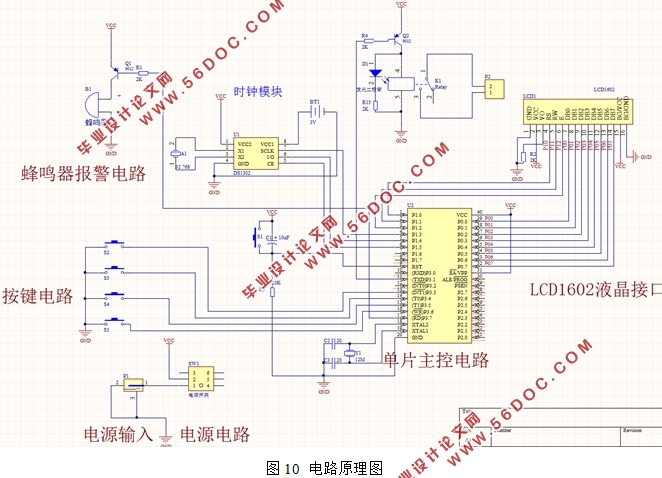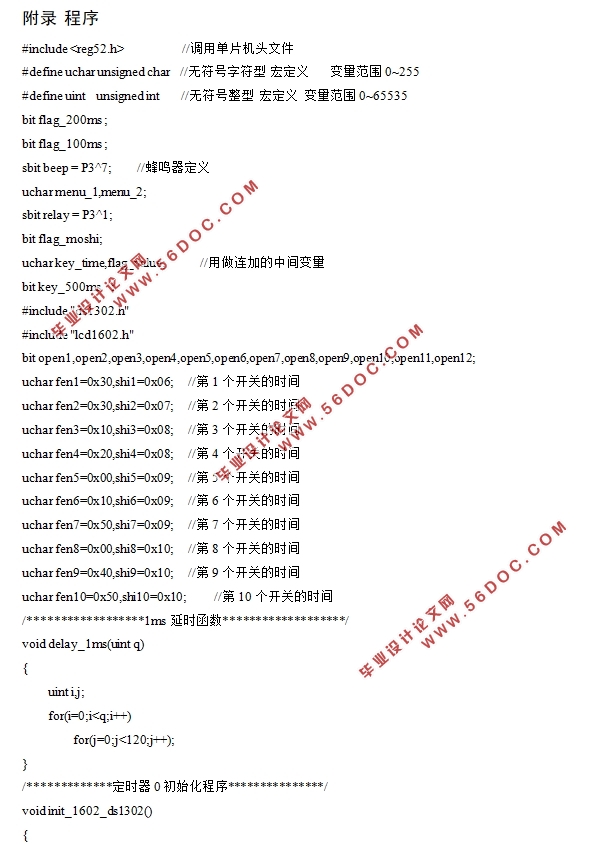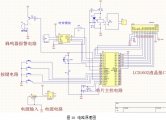基于单片机的定时开关设计(附电路原理图,程序清单)
来源:56doc.com 资料编号:5D21606 资料等级:★★★★★ %E8%B5%84%E6%96%99%E7%BC%96%E5%8F%B7%EF%BC%9A5D21606
资料以网页介绍的为准,下载后不会有水印.资料仅供学习参考之用. 密 保 惠 帮助
资料介绍
基于单片机的定时开关设计(附电路原理图,程序清单)(论文10600字)
摘要:本次毕业设计描述了一个基于STC89C52单片机的定时开关的设计与制作。和现实生活中普通的手动机械开关相比,定时开关可以使用机械按键设置24小时内的任意开关定时时段和6组快速模式定时,单片机通过控制继电器的开关状态即可间接控制外部电器可以定时工作,本次毕设中设计和制作的一个以单片机为基础的定时开关,能定时控制LED灯的工作状态,让LED等在预先设定的时间亮起和熄灭。单片机通过控制继电器的开关状态即可间接控制包括LED灯在内的外部电器定时工作,实现节能环保。
关键词:单片机;STC89C52;定时开关;继电器
Design of timing switch based on single chip microcomputer
Abstract:This graduation design describes the design and fabrication of a timing switch based on the STC89C52 microcontroller. Compared with the ordinary manual mechanical switch in real life, the time switch can use the mechanical button to set any switching timing period within 24 hours and 6 sets of fast mode timing. The single-chip microcomputer can indirectly control the external electrical equipment to work regularly by controlling the switching state of the relay. In this design, a timing switch based on the single-chip STC89C52 is designed and manufactured, which can control the working state of the LED light regularly, and let the LEDs light up and go out at a preset time. The MCU can indirectly control the timing of external electrical appliances including LED lights by controlling the switching state of the relays to achieve energy saving and environmental protection.
Key words:Single chip microcomputer; STC89C52; Time switch; Relay


目 录
摘要
Abstract
1.绪论 5
2.系统设计 5
2.1系统设计任务 5
2.2系统设计方案选择 5
2.2.1单片机芯片的选择 5
2.2.2显示模块选择 6
2.2.3定时设置的选择 6
2.2.4继电器选择 6
2.2.5按键和红外控制模块的选择 6
2.2.6电源选择方案 6
3.硬件电路设计及工作原理 6
3.1主控制器STC89C52 7
3.2 DS1302计时电路 8
3.3 LCD1602显示电路 9
3.4继电器电路 10
3.5蜂鸣器电路 11
3.6总体硬件电路及其工作原理 12
4.软件设计 13
4.1 DS1302计时程序的编写 13
4.2 LCD1602显示电路程序编写 15
4.3红外信号和按键处理程序编写 16
4.4主程序的编写 16
5.系统调试 17
5.1电路设计前期工作 17
5.2硬件电路部分的调试 17
5.3软件部分的调试 17
5.4设计结果 18
6.结束语 19
参考文献 20
致谢 20
|





